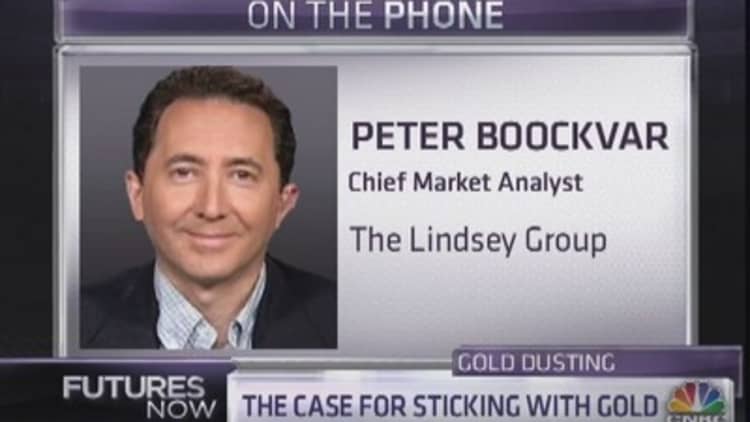
Investors are likely to remember 2013 not only as a banner year for the stocks—but also as a miserable one for gold. With a nearly 30 percent slide, the yellow metal not only suffered its first annual loss since 2000, but its worst year since 1981.
Yet some strategists are contending that the secular bull market for gold remains intact. And in fact, for those who remain wary about the Federal Reserve's quantitative easing program, gold looks far preferable to stocks for 2014.
In gold, we've recently seen "more of a cyclical rather than a secular bear market," said Peter Boockvar on Tuesday's "Futures Now." "It's been up 12 years in a row—it certainly was due for a big pullback."
The outlook for next year will depend on the Fed, the chief market analyst at Lindsey Group went on to argue.
"The gold trade from here could be a question of faith in the Fed or no faith in the Fed," Boockvar said. "Right now, faith in the Fed is very high, as evidenced by the rise in stocks. But I don't have faith in the Fed."
In December, the Fed began to taper down its quantitative easing program, by reducing its monthly asset purchases from $85 billion to $75 billion. The stock market actually rallied on the news, but gold capped an already terrible year by dropping another $30 since that announcement.
Yet to those like Boockvar, who believe the Fed cannot unwind the program without stoking inflation, that drop actually provides a buying opportunity.
"I don't think the Fed can pull this off. I I think the exit is going to be extremely messy. Therefore, in my opinion, gold is a place to hide throughout that quote-unquote 'messiness,' " Boockvar said.
Meanwhile, Boockvar says that QE has been a "crutch" for stocks, adding that "the big crutch in 2013 potentially is not going to be there in 2014."
When looking to catalysts that could drive gold higher, some traders add that the metal has become so beaten down, it could now be a bargain.
"In 2011, gold had this $400 range on the upside, and as soon as it broke $1,525, that became an inflection point," said Brian Stutland of the Stutland Volatility Group. "So I'd expect another $400 drop below that point—that would take us to $1,125. We're not too much off there, so the bottom is probably near."
"If you look at the gold miners themselves, we're getting to the point where it's not very profitable to mine gold," said Anthony Grisanti of GRZ Energy. "So if you see some of those mines slow down or shut down, it could cause a little bit of a strain or a little bit of a contraction in the physical supply, and that could lead to higher prices."
Still, both Stutland and Grisanti were quick to add that as long as strong economic data continue to rain cats and dogs on the gold market, they don't have much conviction in any bullish thesis.
"I'm kind of just throwing straws in the wind right now," Grisanti admitted. "I don't know what's going to take us higher at this point. It still looks lower to me."
—By CNBC's Alex Rosenberg. Follow him on Twitter: @CNBCAlex.




